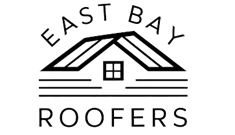If you detect visible water leaks, missing/damaged shingles, or a sagging roof, it's time for professional roof repairs. Mold growth, granules in gutters, storm damage, critter infestations, or rising energy bills also signal the need for expert intervention. Addressing these issues promptly can prevent further damage and costly repairs down the road. Expert evaluations, proper tools, and safety precautions guarantee effective solutions. For thorough assessments and long-term roof health, consulting a professional roofer is key. Don't delay addressing these signs; acting early can save you time and money while safeguarding your home's integrity.
Visible Water Leaks
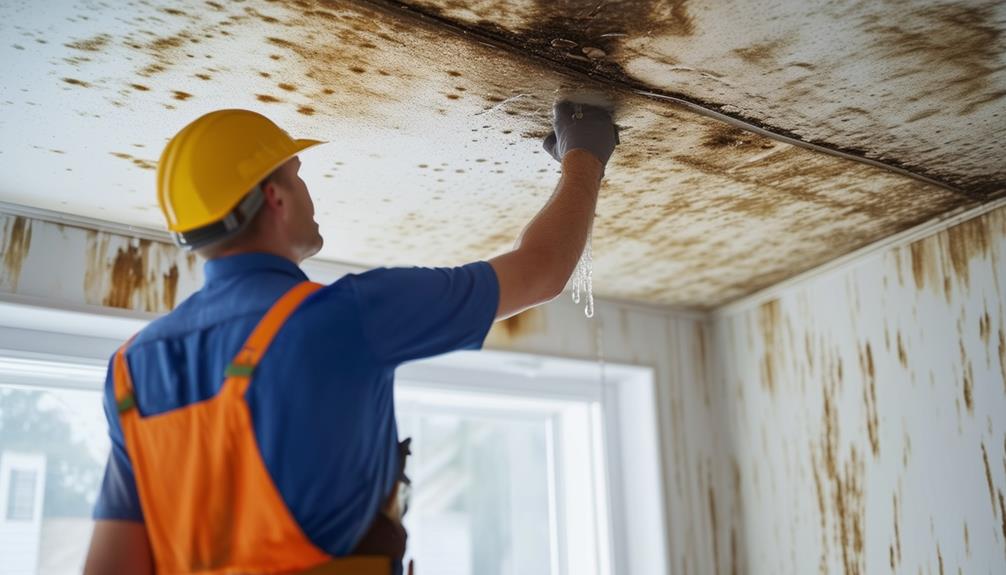
If you notice visible water leaks inside your home, it is essential to promptly contact a professional roofer for an assessment and repair. Professional assessment is vital in determining the root cause of the leak and ensuring proper repairs. Attempting DIY solutions may temporarily alleviate the issue, but without addressing the underlying problem, the leak can persist and potentially lead to more extensive damage.
Prevention methods such as regular roof inspections, maintenance, and timely repairs can help avoid water leaks. A proactive approach can save you from costly repair bills in the long run. When it comes to repair costs, they can vary depending on the extent of the damage and the materials needed. It is advisable to consult with a reputable roofer to get an accurate estimate for the repair work required.
Missing or Damaged Shingles
If you notice missing or damaged shingles on your roof, it could be a sign of underlying water damage. Attempting a DIY repair may pose risks if not done correctly, potentially leading to more extensive issues. Timeliness in addressing missing or damaged shingles is essential to prevent further damage to your roof and home.
Sign of Water Damage
Wondering how to identify signs of water damage on your roof? One of the key indicators to look out for is missing or damaged shingles. When your shingles are compromised, water can seep through and cause significant issues like foundation cracks and interior damage.
Missing or damaged shingles can lead to water infiltration, which in turn can weaken the structure of your roof. This weakening can result in leaks that damage not only the roof but also the interior of your home. If left unaddressed, these leaks can lead to more severe problems such as foundation cracks due to prolonged exposure to moisture.
Regularly inspecting your roof for any missing or damaged shingles is important in maintaining its integrity and preventing water damage. If you notice any issues, it's crucial to call a professional roofer promptly to assess the situation and make the necessary repairs before the problem escalates. Remember, early detection and intervention can save you from costly repairs down the line.
DIY Repair Risks
Inspecting your roof for missing or damaged shingles can help you understand the risks associated with attempting DIY repairs on your own. When it comes to addressing missing or damaged shingles, safety precautions are of utmost importance. Climbing onto a roof can be dangerous, especially for those without experience. It's vital to use proper safety equipment such as harnesses, non-slip shoes, and a stable ladder.
Additionally, having the necessary tools is critical for the job. To replace missing shingles, you will need tools like a hammer, roofing nails, a utility knife, and roofing cement. Without these tools, the repair process can be challenging and may result in improper fixes that could lead to further damage down the line.
While some homeowners may feel confident in their DIY skills, roof repairs, particularly those involving missing or damaged shingles, require precision and expertise to ensure the job is done correctly. If you are unsure about your ability to safely and effectively repair your roof, it may be best to seek professional assistance.
Importance of Timeliness
Regularly checking for missing or damaged shingles is essential for ensuring the integrity of your roof. When you notice any issues with your shingles, it's important to address them promptly to prevent further damage. Timeliness in repairing missing or damaged shingles is key in maintaining the overall health of your roof. By addressing these issues promptly, you can avoid more extensive and costly repairs down the line.
Preventative maintenance is a cornerstone of proper roof care. Timely repair of missing or damaged shingles is a prime example of this. Neglecting to address these issues promptly can lead to water leaks, structural damage, and even mold growth in your home. Regular roof inspections can help you catch these problems early on, allowing you to take swift action.
Sagging Roof
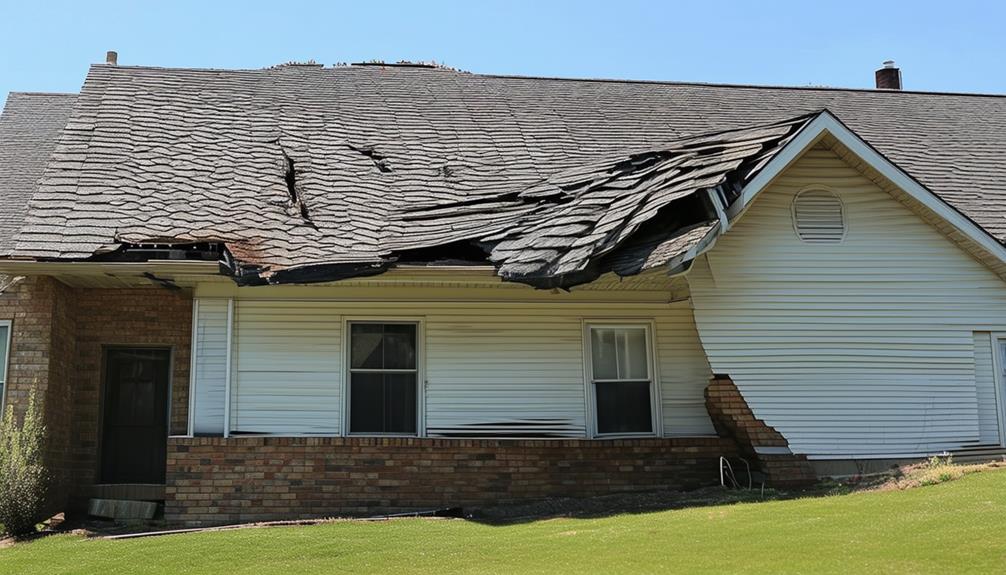
If you notice your roof sagging, it is crucial to call a professional for immediate inspection and repair. A sagging roof can indicate underlying issues with the roof structure or reinforcement, which require prompt attention to prevent further damage. Upon contacting a professional, they will conduct a thorough assessment of the sagging area to determine the cause and extent of the problem.
A professional roofer will have the expertise to identify the root cause of the sagging, whether it be due to structural weaknesses, improper installation, or water damage. They will then recommend appropriate solutions to address the issue effectively. These solutions may involve reinforcing the roof structure, replacing damaged components, or adjusting the load-bearing capacity of the roof.
Attempting to repair a sagging roof without professional assessment and guidance can lead to inadequate fixes that only provide temporary relief. Trusting a professional to handle sagging roof issues ensures that the underlying problems are addressed correctly, preventing future issues and ensuring the safety and integrity of your home.
Mold or Mildew Growth
When mold or mildew growth is visible on your roof, it is a clear indication that professional intervention is necessary to address potential underlying issues promptly. Mold and mildew not only detract from your home's appearance but also pose health risks and can indicate more significant problems with your roof. Here are some essential points to keep in mind:
- Prevention Methods: To prevent mold and mildew growth on your roof, make sure proper ventilation in your attic, trim overhanging branches that can shade the roof, and keep gutters clean to prevent water buildup.
- Expert Guidance: Seeking professional advice is important when dealing with mold or mildew on your roof. Experts can identify the root cause of the growth and recommend the most effective solutions to prevent it from recurring.
- Health Risks and Prevention Tips: Mold and mildew can trigger respiratory issues and allergies. To safeguard your health, avoid direct contact with mold, wear protective gear when handling it, and consider professional mold remediation services for thorough removal.
Granules in Gutters
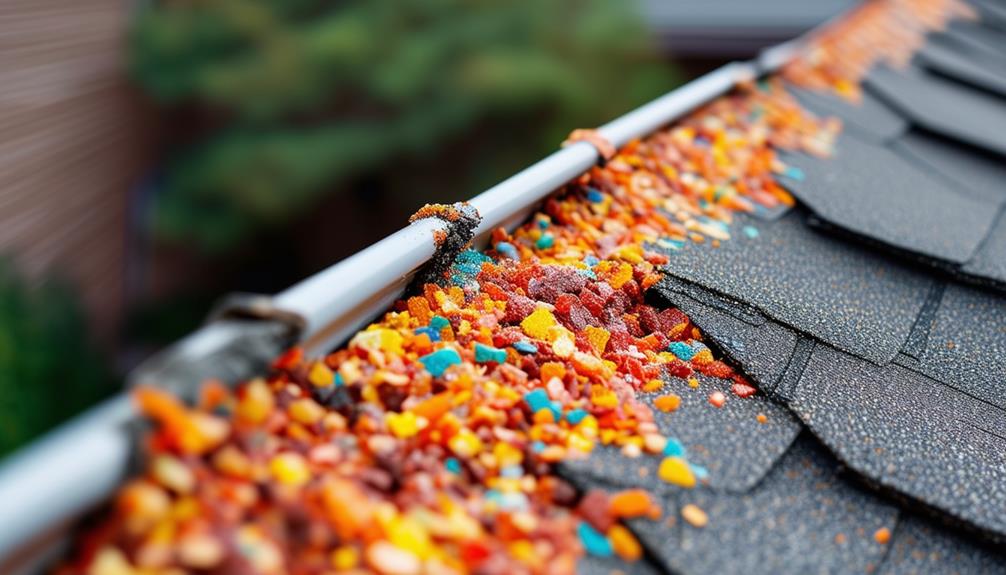
Addressing granules in gutters is vital for maintaining the integrity of your roof and preventing potential water damage. When you notice granules accumulating in your gutters, it is typically a sign that your roof shingles may be deteriorating. These granules, which resemble coarse black sand, help protect your roof from the sun's UV rays and harsh weather conditions. If they are ending up in your gutters, it could indicate that your shingles are losing their protective coating.
Regular roof maintenance and gutter cleaning are essential to prevent granules from clogging your gutters and downspouts. If left unattended, this buildup can obstruct proper water drainage, leading to water pooling on your roof and potentially causing leaks or structural damage. To safeguard the longevity of your roof and prevent costly repairs, it is recommended to address granule buildup promptly by cleaning your gutters regularly and inspecting your roof for any signs of shingle deterioration. By staying proactive with roof maintenance and gutter cleaning, you can protect your home from water damage and prolong the life of your roof.
Age of Roof
As a homeowner, understanding the lifespan limits of your roof is essential. Signs of deterioration, such as curling shingles or sagging areas, indicate that your roof may be reaching the end of its life. When in doubt, seeking an expert evaluation can help determine if repairs or a replacement is necessary.
Roof Lifespan Limits
Consider the age of your roof as an important factor in determining its lifespan limits. A roof's longevity can vary depending on the materials used, weather conditions, and maintenance practices. Here are three key points to help you understand the lifespan limits of your roof:
- Roof Replacement: If your roof is approaching the end of its expected lifespan, considering a roof replacement may be a wise decision to prevent potential leaks and structural damage.
- Maintenance Tips: Regular maintenance, such as clearing debris, inspecting for damage, and addressing issues promptly, can help extend the lifespan of your roof.
- Professional Inspection: Hiring a professional roofer for periodic inspections can provide valuable insights into the current condition of your roof and help you plan for any necessary repairs or replacements.
Understanding the lifespan limits of your roof is vital for ensuring its continued functionality and protecting your home from potential damages. By being proactive and attentive to your roof's needs, you can maximize its lifespan and minimize the risk of costly repairs.
Signs of Deterioration
Inspecting for signs of deterioration in your roof's aging structure is essential to identifying potential issues that may require professional attention. Regular roof inspection is vital to catch problems early on. As your roof ages, it becomes more susceptible to wear and tear. Look out for missing, cracked, or curling shingles, as well as signs of sagging or water damage on the ceiling. These could indicate underlying issues that need immediate repair.
To maintain the longevity of your roof, follow these maintenance tips: schedule annual inspections by a professional roofer, keep gutters clear to prevent water buildup, trim overhanging tree branches to avoid damage, and make sure proper attic ventilation to reduce moisture. Additionally, after severe weather conditions, it's advisable to check for any visible damage promptly.
Expert Evaluation Needed
To determine the necessity for professional assessment, it is crucial to take into account the age of your roof. As roofs age, they become more susceptible to wear and tear, potentially leading to a range of issues that may compromise the safety and integrity of your home. Here are some key factors to keep in mind:
- Safety Concerns: Older roofs are more prone to structural weaknesses, leaks, and other safety hazards. A professional evaluation can identify these risks early on and prevent any accidents or further damage.
- Cost Effectiveness: While repairs can be costly, addressing issues promptly can actually save you money in the long run. Professional roofers can provide insights on whether repairs or a full replacement would be more cost-effective considering the age and condition of your roof.
- Peace of Mind: Knowing that your roof has been thoroughly assessed by experts can give you peace of mind and assurance that your home is protected. Don't underestimate the value of professional advice when it comes to the longevity and safety of your roof.
Storm Damage
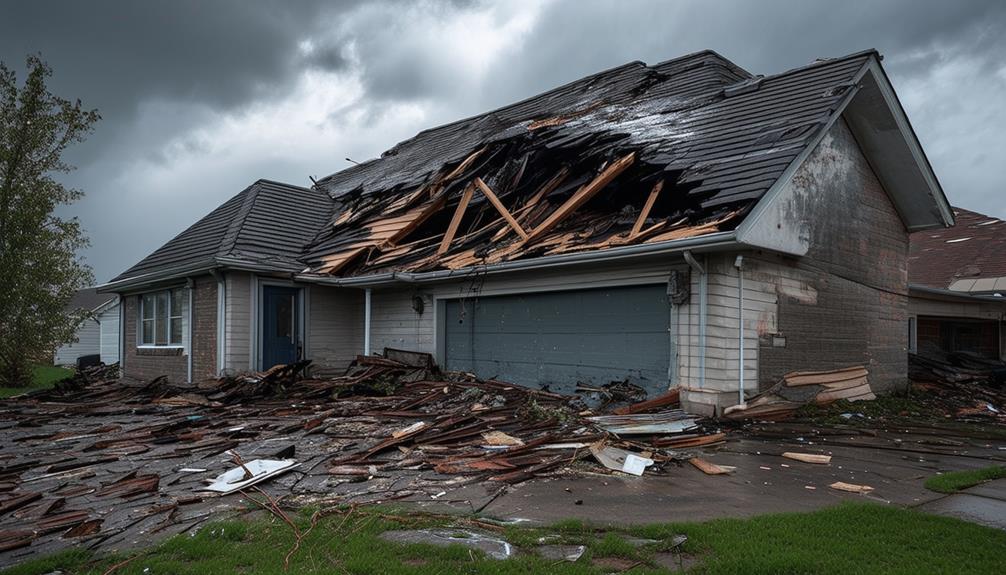
If your roof has been exposed to severe storms, it is important to promptly assess for any potential storm damage. While some damage may be obvious, like missing shingles or leaks, other issues might be less visible but equally concerning. Ignoring storm damage can lead to more significant problems down the line, potentially resulting in the need for a full roof replacement.
To make sure that you are covered financially in case of storm damage, it is essential to review your insurance coverage. Some policies may include coverage for storm damage, making it easier to afford necessary repairs or replacements. However, it is vital to check the specifics of your policy to understand what is and isn't covered.
Engaging in preventative maintenance, such as regular professional inspections, can help detect storm damage early on. Professional roofers can identify issues that may not be apparent to an untrained eye, allowing for timely repairs and potentially avoiding more extensive damage. By staying proactive and addressing storm damage promptly, you can prolong the lifespan of your roof and prevent costly replacements.
Critter Infestation
If you notice signs of critter damage on your roof, such as chewed shingles or droppings, it's important to address the issue promptly. Ignoring critter infestations can lead to structural damage, insulation problems, and even health hazards in your home. Understanding the risks of ignoring these issues can help you make an informed decision about when to call a professional for roof repairs.
Signs of Critter Damage
Look out for telltale signs of critter damage on your roof to detect any potential critter infestation early on. Critters like squirrels, raccoons, or birds can cause significant damage if left unchecked. Here are some signs to watch for:
- Chewed or Scratched Shingles: If you notice shingles that are chewed or scratched, it could be a sign of critters trying to gain entry to your roof.
- Droppings or Urine Stains: Finding droppings or urine stains in your attic or on the exterior of your home indicates critter presence.
- Nesting Materials: Discovering nesting materials such as leaves, twigs, or debris on your roof could mean critters are making themselves at home.
To prevent critter infestations, trim tree branches that are close to your roof, seal any openings or gaps, and consider installing a critter-proof barrier. If you suspect critter damage, it's essential to address it promptly to avoid more extensive repairs down the line.
Risks of Ignoring
Neglecting a critter infestation on your roof poses significant risks to both the structural integrity of your home and the safety of its inhabitants. Critters like raccoons, squirrels, or birds can cause extensive damage if left unchecked. These pests may gnaw on wood, insulation, and wiring, leading to compromised structural integrity and fire hazards. Additionally, their presence can result in safety concerns for your family, as they may carry diseases and parasites.
Ignoring a critter infestation can lead to long-term damage that may necessitate costly repairs. For example, if raccoons nest in your attic, their urine and feces can seep into the ceiling and walls, causing water damage, mold growth, and weakening the structure. Squirrels chewing on electrical wires pose a fire risk, while bird nests can block ventilation systems, leading to potential health hazards.
To safeguard your home's structural integrity and the well-being of its occupants, promptly address any signs of critter infestation on your roof. Investing in professional pest removal services can prevent costly repairs and establish a safe living environment for you and your family.
DIY Repair Failures
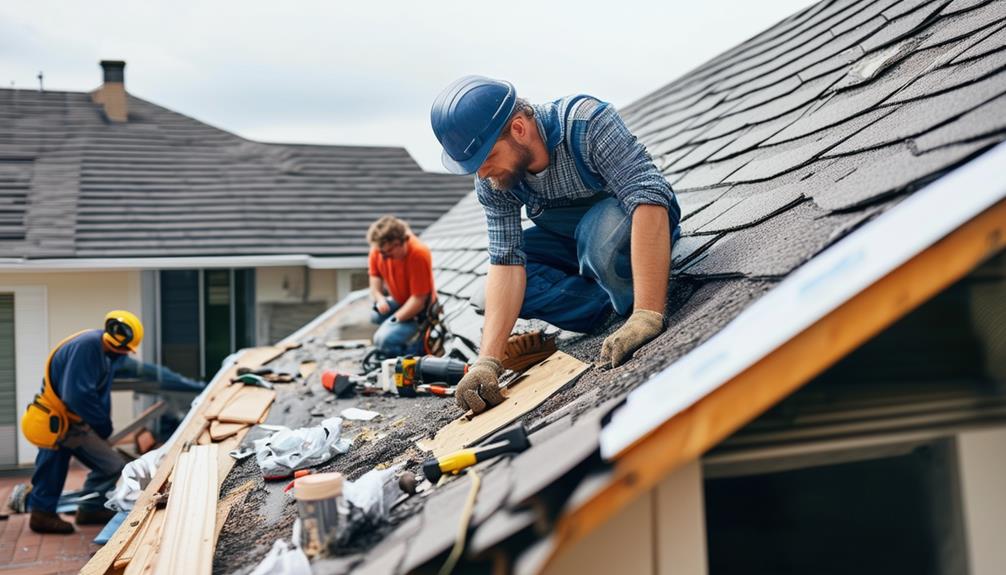
Common among homeowners are instances where attempting to repair the roof on your own results in DIY repair failures. While the idea of saving money and taking matters into your own hands may seem appealing, roofing repairs require a certain level of expertise and experience to be done effectively. Here are some reasons why DIY roof repairs can often lead to more problems: Improper techniques or the use of inadequate materials can exacerbate the issue, leading to larger and more expensive problems down the line. Additionally, mistakes made during DIY repairs may void any existing warranties, leaving homeowners to shoulder the full cost of roof repairs in the future. Hiring a professional ensures the job is done right the first time, saving both time and money in the long run. Moreover, professionals are well-equipped to identify and address underlying issues that an untrained eye might overlook, ensuring a lasting solution rather than a temporary fix. They are familiar with common roofing problems and solutions, such as dealing with leaks, damaged shingles, or poor insulation, which can be challenging for inexperienced homeowners to resolve effectively. By relying on skilled experts, you gain peace of mind knowing that your roof is in capable hands, protecting your home and investment for years to come.
- Lack of Safety Precautions: Roof work can be dangerous, and without proper safety measures in place, you risk accidents and injuries. Professional roofers are trained to work at heights safely, reducing the likelihood of mishaps.
- Inadequate Knowledge: Roofing systems are complex, and without the right expertise, you may end up causing more damage than good. Professionals have the necessary training and experience to identify issues accurately and provide suitable solutions.
- Improper Use of Tools: Using incorrect tools or using tools improperly can result in subpar repairs that may not last. Professional roofers have access to specialized equipment and tools, ensuring the job is done correctly the first time.
To avoid DIY repair failures and make certain your roof is in top condition, it's best to consult with a professional roofer. These experts have the training, experience, and tools necessary to handle a wide range of roofing issues effectively. While DIY roof repair techniques may seem cost-effective at first, improper methods can lead to further damage and expensive repairs down the line. By trusting a professional, you can ensure lasting quality and peace of mind for your home. In addition, professional roofers can identify underlying issues that might not be apparent to an untrained eye, preventing potential problems before they worsen. Their expertise not only saves you time and effort but also ensures the job is done safely and correctly. By searching for roof repair services near you, you can find trusted professionals who are equipped to restore your roof’s integrity and protect your home for years to come.
Increasing Energy Bills
Wondering why your energy bills are on the rise? High humidity and poor insulation in your home's roof could be the culprits. When humidity levels are elevated, your HVAC system works harder to maintain a comfortable temperature, leading to increased energy consumption and higher bills. Poor insulation allows heat to escape during the winter and infiltrate during the summer, causing your heating and cooling systems to run longer than necessary.
High humidity in the attic can result from improper ventilation, which can be exacerbated by roof damage or inadequate insulation. This excess moisture can lead to mold growth, further reducing the insulation's effectiveness and driving up your energy bills. Addressing these issues promptly by consulting a professional roofer can help improve your home's energy efficiency and lower your monthly expenses.
If you've noticed a significant spike in your energy bills, it may be time to have your roof inspected for high humidity levels and insufficient insulation. Investing in proper ventilation and insulation can ultimately save you money in the long run by reducing your energy consumption.
Frequently Asked Questions
Can Roof Repairs Be Covered by Insurance?
If you're wondering if insurance covers roof repairs, it depends on your policy's specifics. Insurance coverage for roof repairs is typically based on the cause of damage, like storms or accidents. However, certain common exclusions, such as regular wear and tear or lack of maintenance, might limit your eligibility for coverage. To determine if your roof repairs can be covered by insurance, review your policy details and consider consulting your insurance provider for clarification.
What Are the Signs of a Roof Nearing the End of Its Lifespan?
As your roof nears the end of its lifespan, signs like missing shingles, sagging areas, and frequent leaks become more prevalent. Did you know that the average lifespan of a roof is around 20-25 years? To prolong your roof's life, regular maintenance is key. Keep an eye out for these warning signs and consider roof replacement if necessary. Implementing maintenance tips can help extend the lifespan of your roof and save you money in the long run.
How Can I Prevent Critter Infestations on My Roof?
To prevent critter infestations on your roof, focus on pest control and roof maintenance. Trim tree branches near the roof to limit access points for animals. Regularly inspect your roof for any signs of damage or openings that could be entry points for pests. Make sure your attic is well-sealed to prevent critters from getting inside. Implement a pest control plan to deter any unwanted visitors from making your roof their home.
What Are the Dangers of Ignoring Minor Roof Issues?
Ignoring minor roof issues is like playing with fire. Without proper roof maintenance, even small problems can escalate quickly. Water damage is a critical concern if leaks are left unchecked. Mold, rotting wood, and structural issues can result from neglecting minor issues. It's important to address any signs of roof damage promptly to avoid costly repairs and guarantee your home remains safe and secure. Regularly inspecting your roof and addressing concerns early can save you from significant headaches down the road. Some common roofing problems to avoid include clogged gutters, cracked shingles, and inadequate ventilation, all of which can compromise the integrity of your roof. Taking proactive steps to maintain your roof ensures long-lasting durability and protects your home from unforeseen expenses. Ignoring these issues not only jeopardizes your home’s structural integrity but also its overall value. By staying informed about roof installation tips and techniques, you can ensure that your roof is installed properly from the start, minimizing the risk of future problems. Additionally, partnering with experienced professionals for regular maintenance and repairs can extend your roof’s lifespan and provide peace of mind for years to come.
Are There Any Environmentally Friendly Roofing Repair Options Available?
When addressing roofing repairs, it's crucial to prioritize eco-friendly materials and sustainable practices. Opting for these options not only reduces your environmental impact but also promotes a healthier living space. Eco-friendly roofing materials like metal, clay, or recycled shingles can enhance your home's energy efficiency and longevity. Implementing sustainable practices during repairs can help minimize waste and contribute to a greener future. Consider these choices for a more environmentally conscious roofing solution. Additionally, incorporating a green roof can further elevate your home’s sustainability by providing natural insulation and reducing stormwater runoff. For successful implementation, explore green roof installation tips, such as selecting the right vegetation and ensuring proper drainage systems. These practices not only enhance your roof’s functionality but also create a positive impact on the environment. Additionally, energyefficient roofing materials can significantly lower your utility bills by improving insulation and reducing the need for excessive heating or cooling. These materials often reflect more sunlight and absorb less heat, keeping your home comfortable year-round. Choosing energyefficient roofing materials not only benefits your household but also supports global efforts to conserve energy and protect natural resources. Additionally, exploring different types of roofing materials can help you make an informed decision tailored to your home’s needs and environmental goals. For instance, cool roofs with reflective coatings are another excellent option to reduce heat absorption and lower energy consumption. By selecting the right types of roofing materials and combining them with sustainable repair practices, you can create a durable, cost-effective, and environmentally conscious roofing system.
Conclusion
Don't wait until it's too late to address roof issues. If you notice any of the signs mentioned, don't hesitate to call a professional for roof repairs. Ignoring these warning signs could lead to more costly damage in the future. Remember, a small leak today could turn into a major problem tomorrow. So, don't delay – contact a professional to assess and fix any issues with your roof before it's too late. Your home's safety and comfort depend on it.
